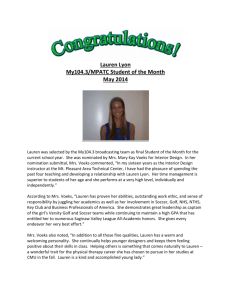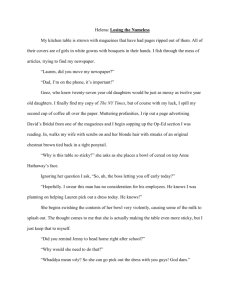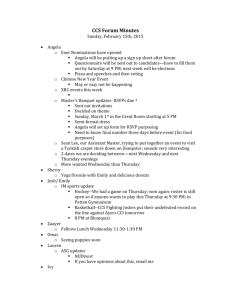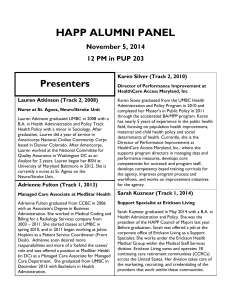Preparing for Midterms Packet
advertisement
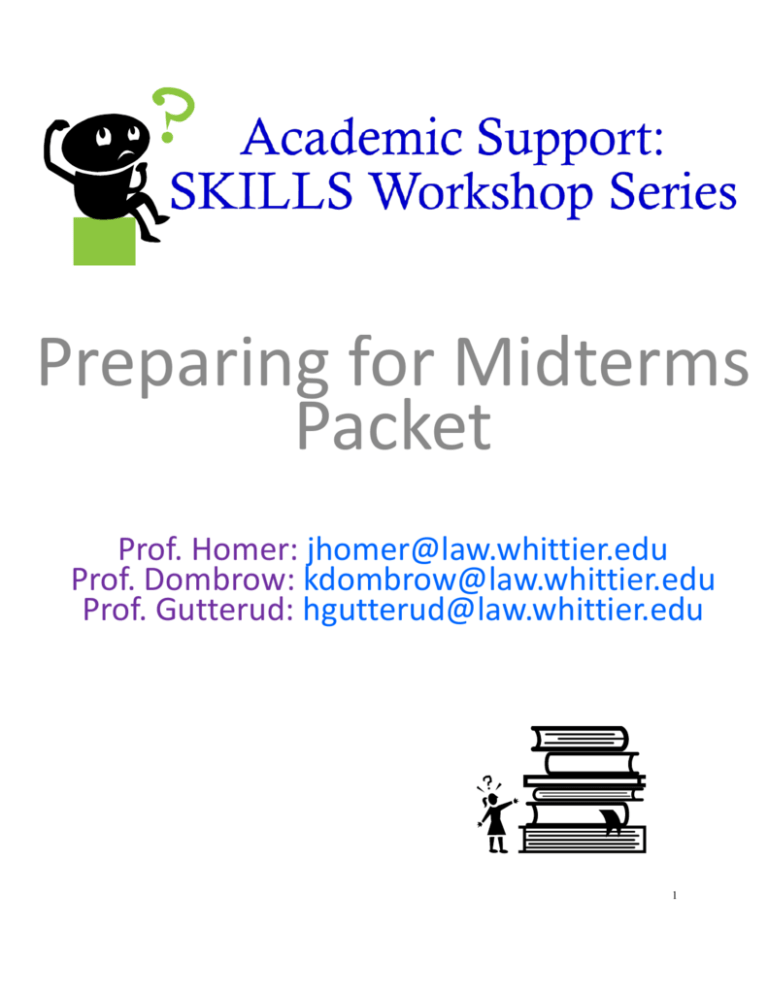
Preparing for Midterms Packet Prof. Homer: jhomer@law.whittier.edu Prof. Dombrow: kdombrow@law.whittier.edu Prof. Gutterud: hgutterud@law.whittier.edu 1 Are They Speaking In Code? For better understanding of what your professor is writing on the board and for speedier note taking, here is a list of useful symbols and their meanings. Trust us; these will come in very handy over the course of law school: JNOV = Judgment notwithstanding the verdict Jx or Jxn = Jurisdiction K = Contract OE = Offeree OR = Offeror PJ = Personal Jurisdiction RAP = Rule Against Perpetuities Rev’d = Reversed SL = Strict Liability SMJ = Subject Matter Jurisdiction SOL = Statute of Limitations TRO = Temporary Restraining order UCC = Uniform Commercial Code v. = Versus w/ = With w/o or w/out = Without In addition to these symbols, which are perfect for condensing notes and outlines, some common law school accessories a student should not be without are a Black’s Law Dictionary and perhaps a supplement or two. For help with note taking, outlining, and determining what, if any, supplement is right for you come to ASP office hours where you can check out a supplement or ask for advice regarding them. Our office hours are: § = Section ∆ or D = Defendant ∏ or P = Plaintiff ¶ = Paragraph $ = Damages Aff’d = Affirmed B = Beneficiary BFP = Bona Fide Purchaser BOP = Burden of Proof COA=Cause of Action Corp = Corporation FI = False Imprisonment FRCP = Federal Rules of Civil Procedure FRE = Federal Rules of Evidence Gov or Gov’t = Government Tuesday Wednesday Thursday Prof. Homer 12:00pm-2:30pm 4:00pm-5:00pm 9:00am-12:00pm 9:00am-12:00pm Prof. Dombrow 9:00am-12:00pm 2:00pm-4:30pm 9:00am-12:00pm 2:00pm-4:30pm 9:00am-12:00pm in library Prof. Gutterud 12:00pm-2:30pm in library 4:00pm-7:00pm in library 8:00am-12:00pm 1:00pm-2:00pm 9:00am-12:00pm 2 Full Length Outline Example (for 1 COA) False Imprisonment RULE: Intentional confinement with no reasonable means of escape, without consent or authority of law, that the plaintiff is aware of. ANALYSIS: Intent—purpose, desire, or knowledge to a substantial certainty. Confinement within a bounded area—an enclosed space with no way out caused by: physical force, threat of force, failure to release, and invalid use of legal authority. Moral pressure and future threats are insufficient. Cases to help: ∏ v. ∆—showed that taking property can cause a FI where if the person left they would not get their prop back=constructive confinement ∏ v. Δ—confinement to a boat was still within a bounded area No reasonable means of escape—locked door, closed space, etc. Jumping out of a window is usually not reasonable Cases to help: Without consent or authority of law Without consent—Δ never received permission. DISCUSS: Implicit (nonverbal) vs. Explicit (verbal/written) Consent Without Authority of Law—Legal authority (cops) or Shopkeeper’s privilege Shopkeeper’s Privilege—where a shopkeeper reasonably believes that a person has unlawfully stolen from their shop they may detain that person for a reasonable period of time while awaiting the police/investigating. ∏ Awareness: The ∏ must be aware of the confinement. ∏ can be made aware by being injured from the confinement. Insert cases your Professor identifies as important/need to know 3 Skeletal Outline Example: Battery—The intentional harmful or offensive touching of another’s person. Intent Harmful or offensive Contact Assault—intentionally causing of apprehension of an imminent harmful or offensive contact. Intent Apprehension Imminence Harmful/Offensive Contact False Imprisonment—Intentional confinement with no reasonable means of escape, without consent or authority of law, of which the ∏ is aware of. Intent Confinement w/ no reasonable means of escape Without consent or Authority of Law ∏’s awareness 4 MC Questions: 1) Rhonda and Remus, teenage hikers, came upon a small abandoned barn. While Rhonda explored the interior of the barn, climbing into a hayloft, Remus explored the exterior. He noticed that a horizontal two-by-four slab of wood could seal the only door to the barn from the outside, preventing anyone inside the barn from exiting. Moving this slab into place, Remus locked Rhonda into the barn and called goodbye to her, ignoring her pleas for release. Hoping to gain the attention of a potential rescuer, Rhonda leaned into a crack in the barn wall and called for help. About half an hour after Remus walked away passerby Pia heard Rhonda’s cries for help but decided to ignore them. An action by Rhonda against Pia for false imprisonment should fail because: (A) Pia did not confine Rhonda (B) Remus is the proper defendant for a claim of false imprisonment (C) Rhonda entered the barn voluntarily (D) Rhonda was a trespasser. 2) During a commercial flight, one of the plane’s three engines stopped working. The captain assured the passengers that the plane could fly safely on its remaining engines and announced that the plane would continue to its scheduled destination. One of the passengers, Frank, was not reassured, and demanded that the plane land at the first available airport. The captain refused, even though the plane’s flight path would take it close to another airport. The plane continued on course and landed on time an hour later at its scheduled destination. Frank brings an action against the airline for false imprisonment. Of the following, which constitutes the airlines' strongest argument? (A) Because the plane landed on time at its original destination, there was no confinement. (B) Because Frank was the only passenger who wanted to land earlier, to have done so would have falsely imprisoned all the other passengers by taking them where they did not want to go (C) Frank’s confinement was not unlawful (D) Frank was not physically harmed by the confinement. 5 2) Frank vs. Airline ANSWER: (A) is incorrect because there was confinement. It was not unlawful, but Frank was certainly confined. (B) is incorrect because it makes no sense. The other passengers would not be falsely imprisoned by landing at a closer airport. In fact their confinement would end sooner than if they proceeded to the original destination. (C) is correct. Frank bought a ticket to a particular destination, as did the other passengers. While one can understand Frank’s anxiety after the engine blowout and his desire to land at a closer airport, there was, in fact, no need to divert the plane. Thus, the airline’s refusal, which kept Frank confined for longer than he wanted to be, was not unlawful. The airline had Frank’s consent to confine him. (D) is incorrect because physical harm is not an element of false imprisonment, as long as the victim knows of the confinement (and Frank is well aware of it in this situation). 6 Multiple Choice Study Chart Location of Question Why You Missed It Correct Statement of Law 7 Practice Exam Lauren is a 26 year old woman with a troubled past and involvement in a failed reality television series. Having been cancelled from her long running show (which was completely real, mind you), she started facing the reality in her own life. She had dropped out of college and therefore had no college degree, had no income, and was starting to prematurely age due to negligent sun exposure. Thinking of all of these things, she became depressed. She turned to her best friend and former love interest, Brody, for help. Brody consoled Lauren the best he could…and then recommended that she turn to religion for guidance. Seeking to change her life and despite the change in her wardrobe that would have to occur, she enrolled in a four-week retreat for young woman held at a local convent in Laguna Beach. After the first week, Sister Heidi, who was in charge of the retreat, explained to the group that it was time to intensify their spiritual work. She explained that each of the women in the group would “encounter the holy spirit.” Sister Heidi took a liking to Lauren. Choosing Lauren to go first into the “encounter”, she led her to a small room in the convent’s cellar, instructing Lauren to remain inside to “search her soul” while the other group members prayed outside. Having always suffered from claustrophobia, Lauren began to panic. She shouted to Sister Heidi that she was frightened, but the nun replied that the encounter was a necessary part of Lauren’s path to righteousness. The women assembled on the other side of the door, prayed louder and louder, while Lauren sat for over an hour trying to control her breathing. Eventually, she exhausted herself and fell asleep. When she awoke, the rest of the group and Sister Heidi crowded around her, congratulating her for successfully “fighting her demons.” Does Lauren have a viable claim for the tort if, in this jurisdiction, False Imprisonment elements are: Intent Confinement in a bounded area w/ no reasonable means of escape Without consent or authority of law Plaintiff awareness 8 Outlining Chart FACT(S) TO SUPPORT/∏’s argument FACT(S) THAT DON’T SUPPORT/∆’s argument Intent Confinement w/ no reasonable means of escape Without Consent or Authority of Law ∏ Awareness 9 I R A Issue #1 (State parties involved + COA [aka issue]) (Black letter law [aka “rule”], accurate and concise) One issue (ex. False Imprisonment) (“Here”/“In this case”/”In the case at bar…”) i (Break down element #1—use heading) r (Rule for element #1) a (Fact + why fact is important for element #1) c (Conclude for element #1—whether it was met or not) i (Continue w/ mini-iracs per element—use headings) r a C I R c (Overall conclusion—only 1 sentence necessary Issue #2 (State parties involved + COA for next issue spotted) 10 Sample A-quality Answer Heidi v. Lauren—False Imprisonment The overarching issue is whether or not Lauren was falsely imprisoned. For Lauren to have a viable claim for False Imprisonment the following elements must be satisfied. 1) There must have been an intentional 2) confinement in an enclosed space that has no reasonable means of escape, 3) the detention must have been without consent or authority of law and 4) the plaintiff must have been aware of the confinement. Issue: Did Sister Heidi Intend to Falsely Imprison Lauren? Rule: The defendant has the requisite intent when she had purpose, desire, or knowledge to a substantial certainty to confine. Analysis: Here, Sister Heidi “led” Lauren into the cellar indicating she wanted Lauren in the cellar room. It is clear that Sister Heidi had the intent to have Lauren in the room, but it is not clear if Sister Heidi had the intent to detain Lauren in the room or just to lead her to an “encounter”. At the beginning of the exercise Lauren was “instructed to remain” in the cellar, this is significant because it is a statement indicating that she was meant to be confined in the cellar and not leave. A further clue to Sister Heidi’s intent can be seen in when Lauren shouted out of the cellar that she was frightened and the nun replied that the encounter was necessary for Lauren’s path to righteous. However, it is unclear if Sister Heidi meant that it was necessary to remain confined in the cellar or that feeling frightened was necessary for the “encounter.” Nonetheless, even if Sister Heidi merely intended the confinement to facilitate an “encounter,” she still intended to confine Lauren in some way. Conclusion: Sister Heidi had purpose, desire, or knowledge to a substantial certainty that her actions would confine Lauren. Issue: Was Lauren confined without a reasonable means of escape? Rule: Lauren must have been confined to a bounded area with no reasonable means of escape. One must be actually confined; moral persuasion is insufficient. Analysis: In this case, the room that Sister Heidi led Lauren to was in the cellar. The room was inside of a cellar, likely underground, indicating that it was not likely to have windows or another door from which to leave. Here, during the “encounter” the nuns prayed “on the other side of the door” indicating that the door was shut with Lauren inside. Therefore, the room with the door shut created a bounded area. We do not know if Lauren had a reasonable means of escape because the facts do not state whether the door was locked or if the praying nuns on the other side of the door were blocking the exit. However, Lauren could have at least attempted to open the door in order to escape the ordeal. Thus, it is unclear whether there was a reasonable means of escape. Lauren may argue that she felt compelled to stay in the room because Sister Heidi was an 11 authority figure within the church and the leader of the retreat and thus she could not say no. Sister Heidi was insistent that participation was “necessary” and the authority she asserted may have kept Lauren from attempting to escape because she felt trapped into participating in the encounter. However, “moral persuasion” explicit (Sister Heidi’s insistence) or implicit (in Lauren’s head), is not sufficient to detain someone. Conclusion: Lauren was confined to a bounded area but it is unclear whether there was a reasonable means of escape. Because Lauren did not even attempt to escape, a jury is likely to find that this element is not met. Issue: Was Lauren confined without consent; did Heidi have authority of law? Rule: There are two types of consent: Express Consent and Implied Consent. Express Consent is verbal consent. Implied consent can be shown though a person’s actions that substitute for verbal consent. The defendant must have acted without legal authority. Analysis: In the case at bar, Lauren initially did sign up/enroll in the course; it could be argued that by doing this she gave her implicit consent to take part in the activity. However, we do not know if Lauren was informed of the activities that she would be engaging in prior to enrolling in the course. Verbally, Lauren never explicitly said that she wanted out of the cellar. She did shout out of the cellar that she was frightened. This was an explicit verbal statement, but the question becomes whether her shouting she was frightened is the same as her saying she did not want to participate and that she wanted out of the cellar. Furthermore, Lauren’s other actions in the cellar do not show that she wanted out of the cellar. She did not attempt to leave and she continued to participate in the activity. This conduct, along with the fact she did not ask to leave the cellar, makes it appear she was consenting to her participation in the activity. Heidi was the leader or authority figure of the retreat. However, religious institutions are not given the authority to detain people against their will for the purpose of enlightenment. Lauren did not steal anything from the property or act unlawfully in any manner; therefore Heidi has no authority to keep her detained in the cellar. Conclusion: While Lauren did not verbally say she consented to the confinement, she did enroll in the course and participate in the activity, which shows an implied consent. In addition she did not ask to leave the activity, again showing implied consent. Sister Heidi was not acting with legal authority. Issue: Was Lauren aware of the confinement? Rule: The plaintiff must be aware of the confinement. Awareness can be garnered from injury caused by the confinement. Analysis: Lauren was claustrophobic indicating that she was acutely aware of small, enclosed spaces before even entering the cellar. When she saw the cellar she was scared, and while inside of the room, with the door shut, she shouted she was frightened. While 12 enclosed in the room she controlled her breathing in order to calm herself down, further indicating that she was aware of the confinement because it activated her anxiety and she had to calm herself down. Sister Heidi may argue that Lauren eventually fell asleep and that while she was asleep she could not possibly be aware of her confinement. However, Lauren was initially aware of the confinement therefore Sister Heidi’s argument would fail. Conclusion: Lauren was aware of the confinement. Overall Conclusion: Lauren will not have a viable claim for False Imprisonment because there was a reasonable means of escape and Sister Heidi had consent. 13 COMPONENTS OF AN “A” ESSAY ANSWER IRAC structure Uses headings for each issue and each sub issue Follows IRAC and “mini IRAC” structure ALWAYS concludes one way or another- does not leave it up in the air Does NOT waste time giving an introduction of the facts Includes defenses in IRAC format Issue Identifies all possible issues in fact pattern and prioritizes “hot issues” Uses short headings to identify issues Clearly states parties involved in the issue statement Use of Facts Discusses ALL of the relevant facts as they are stated in the fact pattern Applies ALL relevant facts to appropriate places of analysis Doesn’t fall for red herrings or waste time discussing facts or issues that aren’t there Analysis Does not just list facts- use legal analysis to argue the fact Is not conclusory—“Heidi led Lauren, therefore she was willfully complied”explain to reader WHY fact is relevant Connects all the dots- do not assume that anything is “obvious” Explains analysis clearly and simply, with short concise sentences Time management Works on time management- proportions his/her time to properly answer all outstanding issues and prioritizes “hot issues” Marks at what time you should be at what portion of the exam to ensure effective self-timing Outlines prior to writing and outlines effectively 14
